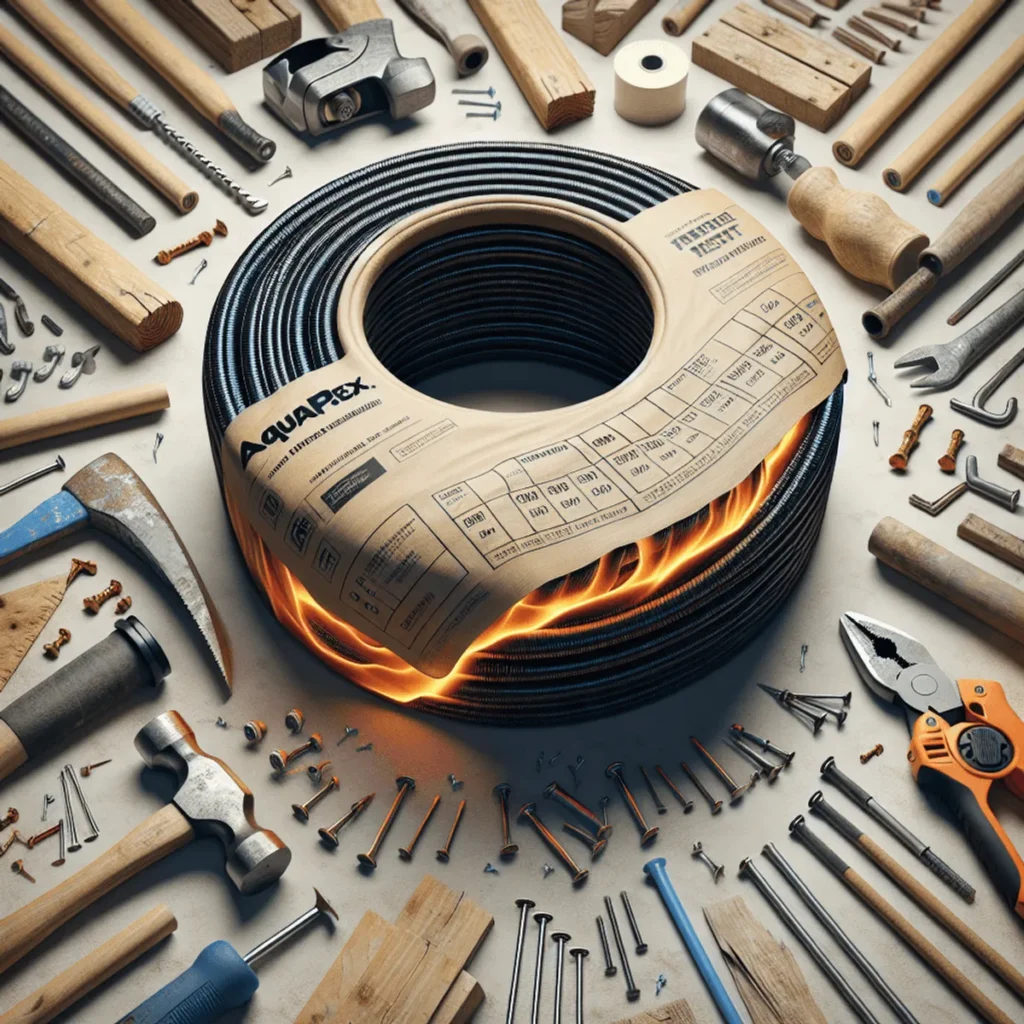When it comes to modern plumbing, Aquapex and PEX are two terms you frequently encounter. Both refer to types of cross-linked polyethylene (PEX) tubing used extensively in plumbing and heating systems. PEX tubing comes in several variations, each with unique properties and applications.
Understanding the differences between Aquapex and other PEX types is crucial for making informed decisions about your plumbing projects. Aquapex, a specific brand manufactured by Uponor, is classified as PEX-A, renowned for its superior flexibility and thermal memory. On the other hand, standard PEX has different classifications like PEX-B and PEX-C, each differing in terms of manufacturing process and performance characteristics.
Comparing these types of PEX tubing can help you select the most suitable option for your specific needs. Factors such as material composition, flexibility, temperature ratings, and cost play significant roles in this decision-making process.
This article will provide a detailed comparison between Aquapex and other PEX types. We’ll look at various factors such as kink resistance, connection methods, usage applications, and regulatory standards to help you understand why one might be better suited for your plumbing needs than another.
1. Material Composition
Aquapex is a specific brand of PEX tubing manufactured by Uponor. It is classified as PEX-A, which refers to the method used for cross-linking polyethylene molecules. Aquapex is produced using the Engel method, known for creating a highly flexible and thermally resilient product.
Other types of PEX tubing include:
- PEX-B: This type is created through the silane method (also known as moisture cure), resulting in a more rigid structure compared to PEX-A. PEX-B is commonly used for water supply systems due to its cost-effectiveness and durability.
- PEX-C: Produced using electron beam irradiation, this type offers moderate flexibility and kink resistance. It provides an alternative for applications where extreme flexibility isn’t necessary.
Understanding these material compositions helps you make informed decisions when comparing PEX vs Aquapex options for your plumbing needs.
2. Flexibility and Kink Resistance
When comparing Aquapex vs standard PEX options, flexibility is a key factor to consider. Aquapex, classified as PEX-A, boasts superior flexibility due to its unique manufacturing process. This flexibility allows for easier installations, especially in tight or complex spaces.
Standard PEX options such as PEX-B and PEX-C are less flexible. They may require additional fittings or support during installation, potentially increasing labor costs and time.
Key Points:
- Aquapex Flexibility: High flexibility, suitable for intricate plumbing configurations.
- PEX-B and PEX-C Flexibility: Reduced flexibility, often requiring more fittings.
Another critical aspect is kink resistance. When installing tubing, kinks can occur, which may compromise the system’s efficiency. Aquapex excels in this area due to its ability to be restored with heat if kinked. Standard PEX options do not recover as effectively from kinks, which can lead to permanent damage or require replacement of the section.
This makes Aquapex a preferred choice where ease of installation and durability are prioritized.
3. Kink Restoration Capabilities
When it comes to kink resistance in Aquapex, this tubing stands out. Aquapex, classified as PEX-A, exhibits superior flexibility and resilience. During installation, kinks are inevitable, but Aquapex’s unique properties allow it to recover effectively.
Key Features of Aquapex Kink Restoration
- Thermal Memory: Applying heat to a kinked section of Aquapex tubing enables it to return to its original shape. This feature makes reworking easier and reduces material waste.
- Durability: The cross-linking process used in PEX-A manufacturing enhances kink resistance, ensuring Aquapex maintains integrity under stress.
- Ease of Installation: Contractors often prefer Aquapex for its ability to withstand bending and kinking during installation without compromising performance.
Comparatively, standard PEX options like PEX-B and PEX-C lack these restorative capabilities. Once kinked, they may not return to their initial form even with heating, requiring replacements. Thus, when weighing Aquapex vs PEX, the ability to restore from kinks efficiently is a significant advantage for Aquapex.
4. Connection Methods
When comparing expansion fittings vs crimp rings for Aquapex tubing, the benefits of using expansion fittings become clear.
Expansion fittings offer several advantages:
- Secure Connections: Expansion fittings create a more reliable and secure connection by expanding the tubing before inserting the fitting. Once the tubing contracts, it forms a tight seal around the fitting.
- Ease of Installation: Using expansion fittings is often easier during installation because they eliminate the need for crimp rings, which require precise placement and tools to install correctly.
- Flexibility in Tight Spaces: Expansion fittings allow for greater flexibility in tight or awkward spaces where using crimp rings might be challenging.
- Reduced Leak Potential: With fewer mechanical connections that can loosen over time, expansion fittings can reduce the potential for leaks, ensuring long-term durability and reliability.
Crimp rings, while common with standard PEX tubing, may not provide these same levels of flexibility and reliability, making expansion fittings a preferred choice for Aquapex installations.
5. Temperature Ratings for Aquapex Tubing
Aquapex tubing is known for its ability to handle high temperatures. It can withstand temperatures up to 200°F at 80 PSI, making it ideal for various uses like hot water distribution and radiant heating systems. When looking at Aquapex vs other types of PEX tubing, such as PEX-B and PEX-C, Aquapex stands out due to its superior ability to handle heat.
Key Comparisons:
- Aquapex vs PEX-B: PEX-B usually has lower temperature limits, often reaching a maximum of around 180°F. This makes Aquapex a more flexible choice when higher temperature tolerance is needed.
- Aquapex vs PEX-C: Like PEX-B, PEX-C also has lower temperature limits compared to Aquapex, generally around 180°F.
- Aquapex vs Copper: Traditional copper pipes can handle extreme temperatures but are prone to corrosion and require more maintenance. Aquapex offers a modern alternative with comparable temperature ratings but with added benefits like flexibility and ease of installation.
When comparing hePex vs Aquapex, hePex—another Uponor product designed specifically for radiant heating—also shares similar high-temperature capabilities, ensuring reliable performance in demanding environments.
These qualities make Aquapex an excellent choice for projects where the ability to withstand high temperatures is crucial.
6. Pressure Ratings for Aquapex Tubing

When looking at the pressure ratings for Aquapex, you’ll see it stands out compared to other PEX types. Aquapex, known as PEX-A, is designed for use in situations up to 200°F at 80 PSI. This high tolerance makes it suitable for a variety of demanding plumbing and heating applications.
In comparison:
- PEX-B usually has a lower pressure rating at higher temperatures, typically around 73°F at 160 PSI but drops significantly at elevated temperatures.
- PEX-C similarly falls behind with pressure ratings that may not meet the rigorous demands of certain installations.
This difference in pressure capabilities shows why Aquapex is often preferred in professional plumbing projects needing high performance and durability. For instance, the Zurn PEX tubing offers robust performance but still doesn’t match the versatility of Aquapex. Furthermore, detailed specifications about Uponor’s Aquapex can provide further insights into its superior pressure ratings and overall functionality.
7. Usage Applications for Aquapex Tubing
Aquapex tubing offers versatility in a variety of plumbing applications due to its superior flexibility and durability. Particularly well-suited for potable water PEX applications, Aquapex ensures the safe and efficient distribution of drinking water.
Key Applications:
Potable Water Systems
- Ensures clean, safe delivery of drinking water.
- High resistance to chlorine and other chemicals commonly found in municipal water supplies.
Radiant Floor Heating
- Excellent thermal properties enhance energy efficiency.
- The flexible nature allows for easy installation in various floor types.
Hydronic Heating Systems
- Withstands high temperatures and pressures, making it ideal for hot water heating systems.
Snow Melting Systems
- Durable enough to be embedded in concrete or asphalt, providing reliable snow and ice melting.
Fire Sprinkler Systems
- Meets stringent safety standards for use in residential fire suppression systems.
The flexibility and resilience of Aquapex make it an excellent choice for both residential and commercial plumbing projects. Its ability to handle high temperatures, pressures, and chemical exposure ensures long-lasting performance across diverse applications.
8. Cost Considerations When Choosing Between Aquapex and Other Types Of PEX TubingCost Considerations When Choosing Between Aquapex and Other Types Of PEX Tubing

Understanding the cost differences between Aquapex and standard PEX options is crucial for making an informed decision. Here are some key points to consider:
- Material Costs: Aquapex, being a premium product, typically costs more than standard PEX-B or PEX-C tubing. This is due to its advanced manufacturing process and superior performance characteristics.
- Installation Costs: While Aquapex may have higher material costs, its ease of installation can save on labor expenses. The use of expansion fittings, which are more secure and reliable, can reduce the likelihood of leaks and future maintenance costs.
- Long-term Savings: The durability and reliability of Aquapex can result in fewer repairs and replacements over time. This makes it a cost-effective choice in the long run despite the initial investment.
When comparing the costs, consider both the immediate outlay and potential savings on labor and maintenance.
Best Practices For Installing Aquapex Tubing In Plumbing Systems
Installation Practices for Aquapex Tubing
To ensure the longevity and efficiency of your plumbing system, follow these best practices when installing Aquapex tubing:
- Expansion Fittings: Use expansion fittings specifically designed for Aquapex. These fittings expand the tubing before inserting the fitting, creating a secure and leak-free connection.
- Proper Tools: Utilize the correct tools such as expansion tools and rings. This ensures that the connections are tight and durable.
- Avoid Sharp Bends: While Aquapex is flexible, avoid sharp bends which can stress the material. Use bend supports or elbows where necessary.
- Thermal Expansion: Account for thermal expansion by leaving enough slack in long runs of tubing.
Importance of Using The Correct Fittings Designed For Each Type
Using the appropriate fittings is crucial:
- Compatibility: Ensure that you use fittings that are compatible with PEX-A tubing. Other types of PEX (PEX-B or PEX-C) may require different fitting methods like crimp or clamp connections.
- Leak Prevention: Incorrect fittings can lead to leaks, compromising the plumbing system’s integrity.
By following these guidelines, you can optimize the performance and durability of your plumbing installations using Aquapex tubing.
10. Regulatory Standards That May Influence The Choice Between Aquapex And Other Types Like B Or C
Regulatory standards play a crucial role in determining the suitability of different PEX tubing types for specific applications. Understanding these standards helps ensure compliance and optimal performance.
Key regulatory factors to consider:
- Building Codes: Local building codes may dictate the type of PEX tubing allowed for particular plumbing applications. For instance, some regions may prefer PEX-A (like Aquapex) due to its superior flexibility and kink resistance.
- Temperature and Pressure Ratings: Regulatory standards often specify minimum temperature and pressure ratings. Aquapex, with its high tolerance (up to 200°F at 80 PSI), generally meets or exceeds these requirements.
- Connection Methods: Certain jurisdictions might have restrictions on connection methods. Expansion fittings used with Aquapex could be mandated over crimp rings for their secure connections and reduced risk of leaks.
Staying informed about these regulatory standards affecting aqua plumbing materials helps you make an educated choice between Aquapex vs PEX options, ensuring both compliance and system reliability.
FAQs (Frequently Asked Questions)
What is Aquapex and how does it differ from other types of PEX?
Aquapex is a type of PEX tubing classified as PEX-A, known for its flexibility and kink resistance. It differs from other types of PEX, such as PEX-B and PEX-C, in terms of material composition and performance characteristics.
How does the flexibility of Aquapex compare to standard PEX options?
Aquapex offers superior flexibility compared to standard PEX options, making it easier to work with during installation. This enhanced flexibility reduces the likelihood of kinking, which can affect water flow.
What are the kink restoration capabilities of Aquapex?
Aquapex has excellent kink resistance and restoration capabilities. If it does become kinked, it can often return to its original shape without significant loss in performance, unlike some standard PEX options.
What connection methods are recommended for Aquapex tubing?
When using Aquapex tubing, expansion fittings are preferred over crimp rings. Expansion fittings create a more secure and reliable connection, which is particularly beneficial for maintaining water pressure and preventing leaks.
What temperature ratings should I consider when using Aquapex tubing?
Aquapex tubing has specific temperature ratings that should be considered during installation. It generally performs well under high temperatures compared to other types of PEX tubing, such as copper and HePEX.
What applications is Aquapex tubing suitable for?
Aquapex tubing is suitable for various applications, particularly in potable water systems. Its material composition ensures safety and compliance with health standards for drinking water.


Comments are closed